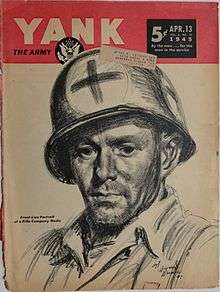Yank, the Army Weekly


Yank, the Army Weekly was a weekly magazine published by the United States military during World War II. The idea for the magazine came from Egbert White, who had worked on Stars and Stripes during World War I. He proposed the idea to the Army in early 1942, and accepted a commission as Lieutenant Colonel. White was the overall commander, Major Franklin S. Forsberg was the business manager and Major Hartzell Spence was the first editor.[1] White was removed from the Yank staff because of disagreements about articles which had appeared.[2] Soon afterward, Spence was also assigned to other duties and Joe McCarthy became the editor.[3]
The first issue was published with the cover date of June 17, 1942. The magazine was written by enlisted rank soldiers only and was made available to the soldiers, sailors, and airmen serving overseas. It was published at facilities around the world—British, Mediterranean, Continental, and Western Pacific—for a total of 21 editions in 17 countries. Yank was the most widely read magazine in the history of the U.S. military, achieving a worldwide circulation of more than 2.6 million. Each issue was priced from five cents to 10 cents because it was felt that if soldiers paid, they would have a higher regard for the publication. Each issue was edited in New York City and then shipped for printing around the world where staff editors added local stories. The last issue was published in December 1945. Scott Corbett (later known as a writer of novels for children) served as the last editor.
Sketch artists such as Robert Greenhalgh,[4] Victor Kalin and Howard Brodie worked on the magazine, which also featured the "G.I. Joe" cartoons by Dave Breger and the Sad Sack cartoons by Sgt. George Baker. Artist and author Jack Coggins spent over two years with Yank, first in New York, then in London, producing illustrations and articles in more than 24 issues. John Bushemi was a photographer, who photographed the Pacific War and provided covers for Yank.[5]
One of the most popular "morale boosters" for the men in the armed forces was the inclusion of a pin-up girl in each issue who was usually clad either in a bathing suit or some form of seductive attire. The pin-up girls included stage and screen stars.
In 2014, the 1st Stryker Brigade Combat Team, 1st Armored Division, Fort Bliss, Texas, revived Yank as the official publication for the brigade. Each cover of the 1/1 Yank features Soldiers from the brigade recreating a cover photo from the original Yank magazine.[6]
In popular culture
Yank figures in the plot of Yank! A WWII Love Story, a musical by Joseph and David Zellnik. The musical had its off-Broadway debut at the York Theatre in New York in February 2010 with a cast including Bobby Steggert, Ivan Herndez, Nancy Anderson and Jeffry Denman.
Yank newspaper with a story that reads "What it means to be a Jewish Girl" is being read by Charles Bronson in an early prison scene in the movie The Dirty Dozen (1967).
References
- ↑ McGurn, Barrett (2004). Yank the Army Weekly: Reporting the Greatest Generation. Fulcrum Publishing. ISBN 1-55591-296-6. page 65
- ↑ White, Egbert. "A Free Press in a Citizen's Army". Journal of Educational Sociology. 19 (4): 236–248. JSTOR 2263264.
- ↑ McGurn p 87-89
- ↑ "They Drew Fire - Robert Greenhalgh". pbs.org.
- ↑ "Operations Against the Japanese on Arundel and Sagekarsa Islands". World Digital Library. 1943. Retrieved 2013-06-02.
- ↑ "1st Brigade Combat Team, 1st Armored Division". Defense Imagery and Video Distribution System. Retrieved 2015-03-12.
External links
| Wikimedia Commons has media related to Yank, the Army Weekly. |
- "The Art of Yank Magazine: The World War Two Drawings of Robert Greenhalgh". Special Collections, Brown University Library. Retrieved February 13, 2013.
- "Yank". (Cover, February 20, 1944 issue, British edition) National Museum of American History. Retrieved February 13, 2013.
- "Army: Yank Magazine – All Editions". (Archive of select issues) Wartime Press. Retrieved February 13, 2013.
- Yank archives, UNZ.org